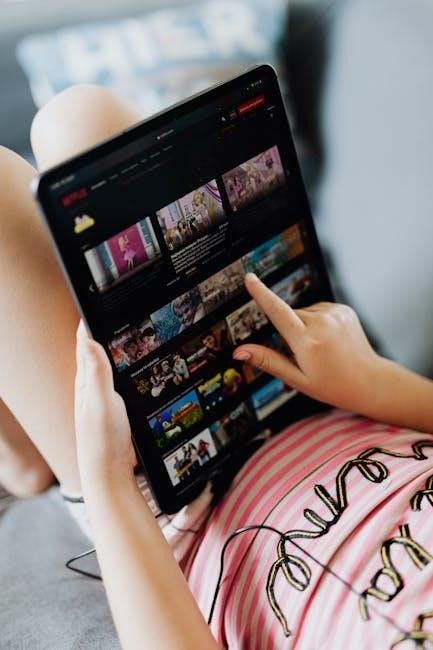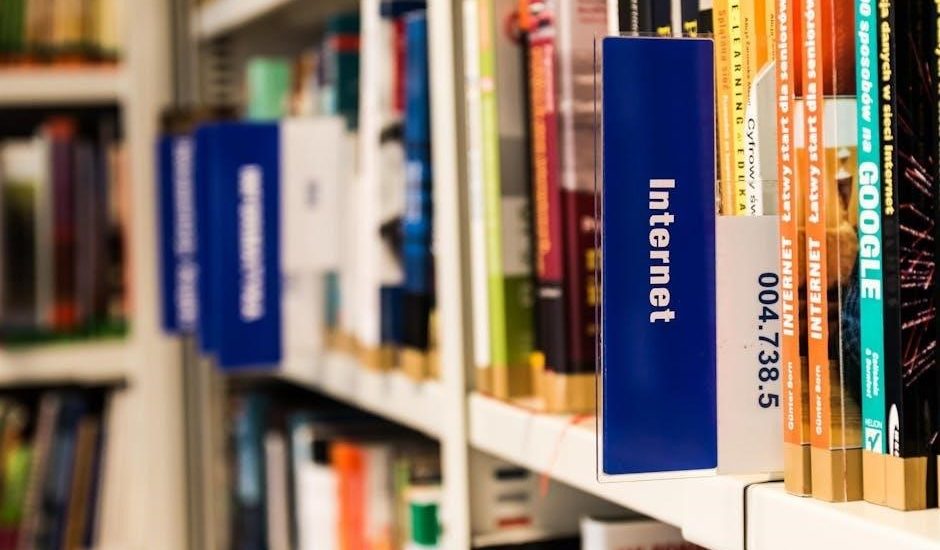Instructional technology and media are essential for effective teaching and learning, serving as powerful instructional aids․ They empower students and educators through innovative digital tools and resources․
1․1 Definition and Scope of Instructional Technology
Instructional technology, also known as educational technology, refers to the development and use of tools, materials, and systems to enhance teaching and learning․ It encompasses a wide range of resources, from traditional media like films and radio to modern digital tools such as learning management systems (LMS) and educational apps․ The scope of instructional technology includes the systematic application of psychological, social, and scientific principles to create effective learning environments․ It aims to improve educational outcomes by making learning more engaging, accessible, and efficient․ Instructional technology also involves research, design, and evaluation to continuously innovate and adapt to educational needs․
1․2 The Role of Media in Learning
Media plays a vital role in enhancing learning by engaging students through visual, auditory, and textual elements․ It provides diverse ways to present information, catering to different learning styles․ Digital media, such as videos and multimedia resources, increases student engagement and understanding․ Media literacy is crucial in the digital age, enabling learners to critically evaluate and effectively use information․ By integrating various media types, educators can create dynamic and inclusive learning environments that promote active participation and deeper comprehension of complex concepts․
1․3 Historical Evolution of Educational Technology
Educational technology has evolved significantly over time, from early tools like film and radio to modern digital solutions․ Initially, instructional aids such as television and computers were introduced to enhance teaching․ The rise of the internet and multimedia resources revolutionized learning, offering interactive and accessible content․ Advances in software and hardware have enabled personalized learning experiences․ Today, digital tools and online platforms dominate, providing diverse opportunities for engagement and innovation․ This progression highlights the transformative impact of technology on education, shaping how we teach and learn in the 21st century․

Key Components of Instructional Technology
Instructional technology includes learning management systems, educational software, and multimedia resources, all designed to enhance teaching and learning through interactive and engaging digital solutions․
2․1 Learning Management Systems (LMS)

Learning Management Systems (LMS) are robust platforms that streamline course management, enabling educators to deliver content, track student progress, and facilitate communication․ They support hybrid and online learning environments, offering tools like discussion boards, grade tracking, and assignment submission․ LMS platforms enhance organization and accessibility, making learning materials available anytime․ They also integrate with multimedia and educational software, creating a comprehensive learning experience․ By centralizing resources, LMS tools promote efficiency and engagement, benefiting both students and educators in modern educational settings․
2․2 Educational Software and Apps
Educational software and apps provide interactive and personalized learning experiences, enhancing student engagement and understanding․ These tools offer multimedia-rich content, simulations, and real-time feedback, catering to diverse learning styles․ Apps like Khan Academy and Duolingo enable self-directed learning, while software such as GeoGebra supports subject-specific exploration․ They facilitate collaboration and creativity, making complex concepts accessible․ By integrating technology, these resources empower students to take charge of their learning, fostering critical thinking and problem-solving skills in dynamic educational environments․
2․3 Multimedia Resources for Instruction
Multimedia resources combine text, images, audio, and video to create engaging and interactive learning experiences․ These tools enhance understanding by presenting information in diverse formats, catering to different learning styles․ Videos, simulations, and animations simplify complex concepts, while audio elements like podcasts provide additional context․ Platforms like YouTube Education and TeacherTube offer accessible multimedia content for various subjects․ Multimedia resources foster active learning, encouraging students to explore and interact with material dynamically․ They also support collaboration, enabling educators to create immersive lessons that captivate students and deepen their comprehension of key topics․
Media for Learning
Media enhances learning experiences by engaging students through diverse formats, fostering collaboration, and providing interactive opportunities․ It plays a crucial role in modern educational strategies and outcomes․
3․1 Types of Educational Media: Visual, Audio, and Textual
Educational media encompasses visual, audio, and textual formats, each offering unique learning opportunities․ Visual media, such as videos and images, enhances understanding through visuals․ Audio media, like podcasts, engages auditory learners․ Textual media, including e-books and websites, provides detailed information․ These formats cater to different learning styles, ensuring diverse engagement and effective knowledge retention․ By integrating these media types, educators can create inclusive and dynamic learning environments that support student success in various ways․

3․2 The Impact of Digital Media on Student Engagement
Digital media significantly enhances student engagement by offering interactive and immersive learning experiences․ Multimedia resources, such as videos and simulations, capture students’ attention and encourage active participation․ Interactive lectures and collaborative tools foster engagement by allowing real-time interaction and idea sharing․ Personalized learning experiences through digital media cater to individual preferences, increasing motivation and involvement․ Additionally, digital media enables immediate feedback, helping students track their progress and stay invested in their learning journey․ Overall, digital media creates a dynamic and inclusive environment that boosts student engagement and promotes meaningful learning outcomes․
3․3 Media Literacy in the Digital Age
Media literacy is a critical skill in the digital age, enabling individuals to critically analyze and effectively use various forms of media․ It involves understanding how to evaluate sources, identify biases, and recognize misinformation․ As digital media becomes pervasive, students must learn to navigate and interpret visual, audio, and textual content responsibly․ Media literacy fosters critical thinking, empowering learners to engage with technology thoughtfully․ Educators play a key role in teaching these skills, ensuring students can discern credible information and use media ethically․ This competency is essential for fostering informed and engaged digital citizens in today’s interconnected world․

Instructional Design and Technology
Instructional design and technology involve applying systematic principles to create effective learning experiences․ It helps educators integrate technology and promote active, collaborative, and engaging learning environments for students․
4․1 Learning by Design: Principles and Practices
Learning by Design emphasizes creating structured learning experiences aligned with educational objectives․ It involves systematic planning, implementation, and evaluation of instructional strategies․ Educators use evidence-based practices to ensure content is engaging and relevant․ This approach encourages active participation and collaboration, fostering deeper understanding․ Teacher design teams play a crucial role in developing these strategies, ensuring alignment with curriculum goals․ Interactive lectures and hands-on activities are key components, promoting student engagement and critical thinking․ By integrating technology and media, Learning by Design enhances the learning process, making it more dynamic and effective for diverse learners․
4․2 Teacher Design Teams and Collaborative Learning
Teacher design teams are collaborative groups of educators who work together to develop and implement effective instructional strategies․ By pooling expertise, these teams create learning experiences that align with curriculum goals and student needs․ Collaborative learning encourages active participation, fostering creativity and problem-solving skills․ Technology and media tools, such as multimedia resources and educational software, support these efforts․ Teacher design teams ensure that lessons are engaging and relevant, while collaborative learning environments promote peer interaction and shared knowledge construction․ This approach enhances student engagement and prepares learners for real-world challenges in a technology-driven world․
4․3 Interactive Lectures and Student Participation
Interactive lectures are dynamic teaching methods that foster student engagement and active participation․ By integrating technology and media, educators can create immersive learning experiences that captivate students․ Tools such as polls, quizzes, and multimedia presentations enable real-time interaction, allowing students to contribute ideas and collaborate․ This approach not only enhances understanding but also encourages critical thinking and creativity․ Teachers can use digital platforms to gauge student comprehension instantly, providing immediate feedback․ Interactive lectures transform passive learning into an engaging, student-centered experience, preparing learners to thrive in a technology-driven world while fostering a sense of community and shared discovery in the classroom․

Technology-Enhanced Learning Environments
Technology-enhanced learning environments promote active engagement and collaboration, utilizing tools like multimedia and interactive devices to support innovative teaching methods and foster deeper student involvement․
5․1 The Role of Classroom Technology in Active Learning
Classroom technology transforms learning environments into interactive spaces, enabling students to engage actively with content․ Tools like multimedia and digital creation tools allow hands-on application of knowledge, fostering deeper understanding․ They facilitate collaboration and real-time feedback, making learning dynamic and inclusive․ By integrating technology, educators can cater to diverse learning styles, ensuring all students participate meaningfully․ This approach not only enhances engagement but also prepares students for a technology-driven world, equipping them with essential skills for future success․
5․2 Multiple Device Classrooms: Challenges and Opportunities
Multiple device classrooms offer both opportunities and challenges․ They enable personalized learning, as students can use devices tailored to their needs, and foster collaboration through shared digital resources․ However, managing diverse devices can be complex, requiring educators to ensure compatibility and access for all students; Additionally, distractions and equity issues may arise if not properly addressed․ Despite these challenges, multiple device classrooms promote engagement and prepare students for a technology-driven future, emphasizing the need for balanced and strategic use of technology to enhance learning outcomes․
5․3 Video and Multimedia Integration in Teaching
Video and multimedia integration in teaching enhances engagement and understanding by making complex concepts visually accessible․ Educators can use videos to demonstrate processes, simulations, or real-world applications, catering to diverse learning styles․ Multimedia tools, such as interactive simulations and animations, enrich lessons, fostering deeper comprehension․ These tools also encourage active participation, as students can interact with content dynamically․ However, effective integration requires access to robust technology infrastructure and teacher training․ When balanced with traditional methods, video and multimedia can create immersive learning experiences, preparing students for a visually driven world while addressing individual learning needs effectively․
Research and Innovation in Instructional Technology
Research and innovation in instructional technology drive advancements in education, enhancing teaching methods and addressing learning challenges through collaborative efforts between educators and technologists․
6․1 Case Studies on Technology Integration in Education
Case studies on technology integration in education highlight successful strategies for enhancing learning environments․ These studies demonstrate how tools like Learning Management Systems (LMS) and multimedia platforms improve student engagement and outcomes․ For instance, classrooms using video conferencing tools for collaborative projects show increased participation and cross-cultural understanding․ Additionally, interactive lectures and digital creation tools foster active learning, enabling students to express ideas creatively․ Such case studies also address challenges like the digital divide, emphasizing the importance of equitable access to technology․ By analyzing these examples, educators can adopt effective practices, ensuring technology enhances teaching and learning for all students․
6․2 The Journal of Instructional Technology and Distance Learning
The Journal of Instructional Technology and Distance Learning is a prime resource for exploring innovations in education․ It focuses on research and case studies that examine the integration of technology in teaching and learning․ The journal covers topics such as distance learning, multimedia integration, and the impact of digital tools on student engagement․ By publishing empirical studies and theoretical frameworks, it provides educators with insights to enhance instructional practices․ This publication is essential for understanding how technology shapes modern education and supports the development of effective learning environments, both in-class and online․
6․3 Emerging Trends in Educational Technology Research
Emerging trends in educational technology research focus on innovations like AI, VR, and gamification․ These tools enhance learning by providing personalized experiences and immersive environments․ AI adapts content to individual needs, while VR and AR create interactive simulations․ Gamification engages students through competitive elements․ Researchers also explore the role of machine learning in predicting learning outcomes and improving instructional strategies․ Additionally, the integration of big data and analytics offers insights into student behavior and performance․ These advancements aim to address challenges like the digital divide and ensure equitable access to quality education, fostering a more inclusive and adaptive learning landscape for the future․
Digital Tools for Learning
Digital tools, such as learning apps and online platforms, empower students to engage in self-directed and interactive learning, fostering engagement and personalized educational experiences effectively․
7․1 Learning Tools for Self-Directed Learning
Self-directed learning tools empower students to take control of their education, fostering independence and personal growth․ These tools include educational software, apps, and online platforms that provide interactive content, quizzes, and resources tailored to individual needs․ Students can set learning goals, track progress, and engage with materials at their own pace, enhancing retention and understanding․ Such tools also promote critical thinking and problem-solving skills, enabling learners to explore topics deeply․ By leveraging these technologies, students develop self-efficacy and confidence, preparing them for lifelong learning in an ever-evolving world․
7․2 Using Digital Creation Tools for Active Learning
Digital creation tools empower students to engage in active learning by producing content rather than passively consuming it․ Tools like multimedia presentation software, graphic design apps, and video editing platforms enable students to express ideas creatively․ These tools foster problem-solving skills, collaboration, and critical thinking․ For example, students can create presentations, infographics, or videos to demonstrate understanding of concepts․ Such activities enhance engagement and retention, making learning interactive and meaningful․ By integrating digital creation tools, educators encourage students to take ownership of their learning, promoting innovation and deeper understanding of subject matter․
7․3 The Role of Search Engines and Online Resources
Search engines and online resources play a pivotal role in modern education by providing instant access to vast amounts of information․ Students and educators can leverage platforms like Google Scholar, online libraries, and educational databases to gather credible sources for research․ These tools enable self-directed learning, allowing students to explore topics independently․ Additionally, online resources such as Khan Academy and Coursera offer supplementary learning materials․ Effective use of these tools requires digital literacy skills, including the ability to evaluate sources for credibility and relevance․ By integrating search engines and online resources, learners can enhance their research capabilities and deepen their understanding of subject matter․

The Impact of Technology on Teaching and Learning
Technology enhances collaboration, engagement, and personalized learning, while also supporting formative research and evaluation․ It fosters innovation but requires balance to maintain effective learning environments and outcomes․
8․1 Technology as a Catalyst for Collaboration
Technology fosters collaboration by enabling real-time communication and resource sharing among students and educators․ Tools like video conferencing and online platforms facilitate teamwork, regardless of location․ Digital collaboration tools, such as shared documents and discussion forums, promote active participation and idea exchange․ This enhances problem-solving and critical thinking skills․ By breaking down geographical barriers, technology ensures inclusivity and diversity in learning environments․ It also supports peer-to-peer learning, encouraging students to take ownership of their education․ However, effective collaboration requires intentional use of technology to avoid distractions and ensure meaningful engagement․ Balancing technology use is key to maintaining productive collaborative learning experiences․
8․2 The Role of Technology in Formative and Evaluative Research
Technology plays a pivotal role in formative and evaluative research by providing tools to assess student learning and instructional effectiveness․ Digital platforms enable educators to gather real-time data through quizzes, polls, and assignments, helping identify knowledge gaps․ Analytics tools allow for the tracking of student progress over time, informing data-driven decisions․ Technology also facilitates the administration of formative assessments, enabling immediate feedback and adaptive learning strategies․ Evaluative research benefits from technology through the use of surveys, interviews, and performance metrics to measure the impact of instructional methods․ These insights support continuous improvement in teaching practices and student outcomes, fostering a more responsive educational environment․
8․3 Balancing Technology Use in Classrooms
Balancing technology use in classrooms is crucial to ensure it enhances learning without causing distractions․ While technology offers numerous benefits, overuse can lead to decreased focus and reduced academic performance․ Educators should establish clear guidelines for when and how technology is used, ensuring it aligns with learning objectives․ Strategies like designated tech-free zones or time limits can help maintain balance․ Additionally, encouraging active learning techniques, such as group discussions or hands-on activities, can minimize reliance on screens․ By integrating technology thoughtfully, educators can create an environment that maximizes engagement while fostering critical thinking and collaboration․

Challenges and Considerations
Challenges include the digital divide, ensuring equitable access, and ethical use of technology․ Effective integration requires balancing benefits with potential distractions and privacy concerns․
9․1 The Digital Divide and Access to Technology
The digital divide remains a significant challenge, as not all students have equal access to technology․ Disparities in internet connectivity, device ownership, and digital literacy create barriers to learning․ Schools in underserved areas often lack the resources to provide modern tools, exacerbating educational inequalities․ Ensuring equitable access is crucial for fostering inclusive learning environments․ Governments and educational institutions must collaborate to bridge these gaps, providing affordable solutions and promoting digital inclusion․ Addressing the digital divide is essential for maximizing the potential of instructional technology and media in education․
9․2 Ensuring Effective Use of Technology Tools
Ensuring effective use of technology tools requires strategic planning and support․ Professional development for educators is crucial to enhance their technical skills and integrate tools meaningfully․ Schools must provide reliable infrastructure and technical assistance to minimize disruptions․ Aligning technology use with learning objectives ensures relevance and engagement․ Regular monitoring and feedback help assess the impact of tools on student outcomes․ Additionally, fostering collaboration between teachers and students encourages innovative uses of technology․ Balancing technology use with traditional methods ensures a well-rounded educational experience․ By addressing these factors, educators can maximize the benefits of technology tools in the classroom․
9․3 Ethical Considerations in Educational Technology
Ethical considerations in educational technology focus on ensuring responsible use of digital tools․ Privacy and data protection are critical, as student information must remain secure․ Equity in access to technology is another key concern, addressing disparities among learners․ Digital citizenship and media literacy are essential to guide ethical online behavior․ Additionally, intellectual property rights must be respected when using educational resources․ Transparency in how technology is used for grading or monitoring is vital to maintain trust․ Finally, cultural sensitivity must be upheld to avoid biases in digital content․ Addressing these ethical issues fosters a fair and inclusive learning environment․

Future Directions in Instructional Technology and Media

Future directions in instructional technology and media focus on AI, VR, AR, and gamification, enhancing personalized learning and real-time feedback for dynamic education․
10․1 The Role of Artificial Intelligence in Education
Artificial Intelligence (AI) is transforming education by enabling personalized learning experiences․ AI tools, such as virtual teaching assistants and adaptive learning platforms, help tailor instruction to individual needs, enhancing engagement and efficiency․ AI-driven analytics provide real-time feedback, allowing educators to identify gaps and improve outcomes․ Additionally, AI automates administrative tasks, freeing up instructors to focus on teaching․ From intelligent tutoring systems to content curation, AI is reshaping how knowledge is delivered and accessed, making education more accessible and effective for diverse learners in the digital age․
10․2 Virtual and Augmented Reality in Learning
Virtual Reality (VR) and Augmented Reality (AR) are revolutionizing education by providing immersive and interactive learning experiences․ VR enables students to explore complex environments, such as historical sites or molecular structures, fostering deeper engagement and understanding․ AR enhances real-world learning by overlaying digital information onto physical objects, making concepts like 3D simulations or interactive models more accessible․ These technologies personalize learning, cater to diverse learning styles, and simulate real-world scenarios for practical training․ Despite challenges like high costs and the need for specialized skills, VR and AR hold immense potential to transform traditional teaching methods and create innovative learning opportunities․
10․3 Gamification and Game-Based Learning
Gamification and game-based learning are transformative approaches that integrate game design elements into educational contexts․ Gamification motivates students through points, badges, and leaderboards, fostering engagement and friendly competition․ Game-based learning immerses students in interactive environments where they solve problems, complete quests, and learn through trial and error․ Both methods enhance critical thinking, creativity, and problem-solving skills․ They also provide immediate feedback, allowing students to track their progress․ By making learning fun and interactive, these strategies cater to diverse learning styles and prepare students for real-world challenges in an engaging and effective manner․
Instructional technology and media revolutionize learning by enhancing collaboration, engagement, and accessibility․ They prepare students for future challenges, fostering innovation and continuous growth in education․
11․1 The Importance of Integrating Technology and Media in Education
Integrating technology and media into education enhances engagement, collaboration, and access to diverse learning resources․ It fosters innovation, personalization, and prepares students for future challenges․ By leveraging digital tools, educators can create dynamic, inclusive environments that cater to varied learning styles․ Technology also bridges gaps, ensuring equitable access to quality education․ Media enriches content, making complex concepts more understandable․ This synergy between technology and media empowers learners, promoting deeper understanding and lifelong skills․ Ultimately, it transforms teaching and learning, driving educational progress and adaptability in an ever-evolving world․
11․2 The Need for Continuous Innovation and Adaptation
The rapid evolution of technology demands continuous innovation in education to maintain relevance and effectiveness․ Educators must adapt to new tools, methodologies, and global connectivity to enhance learning experiences․ Innovation fosters engagement, personalization, and prepares students for future challenges․ By integrating emerging technologies, education can address diverse learning needs, improve outcomes, and stay aligned with societal advancements․ Continuous adaptation ensures educational systems remain responsive to changing demands, equipping students with the skills needed for success in a dynamic world․ This ongoing commitment to innovation is vital for sustaining educational progress and relevance․
11․3 The Future of Learning with Instructional Technology and Media
The future of learning is poised to be transformed by advancements in instructional technology and media․ Emerging technologies like AI, VR, and AR will create immersive, personalized learning experiences․ These tools will enable real-time feedback, adaptive learning paths, and enhanced engagement․ Collaborative platforms will foster global connections, breaking down geographical barriers․ The integration of gamification and interactive simulations will make complex concepts more accessible․ As technology evolves, it will empower educators to design dynamic, student-centered environments․ Continuous innovation will ensure learning is more effective, equitable, and aligned with the needs of a rapidly changing world․



